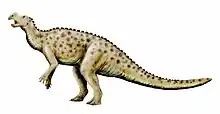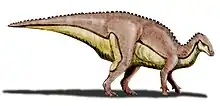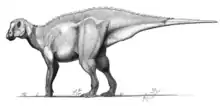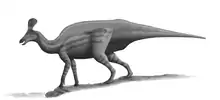| Lambeosaurini Temporal range: Late Cretaceous, | |
|---|---|
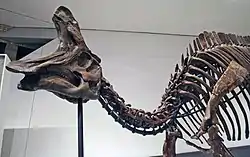 | |
| Mounted L. lambei skeleton, Royal Ontario Museum | |
| Scientific classification | |
| Domain: | Eukaryota |
| Kingdom: | Animalia |
| Phylum: | Chordata |
| Clade: | Dinosauria |
| Clade: | †Ornithischia |
| Clade: | †Ornithopoda |
| Family: | †Hadrosauridae |
| Subfamily: | †Lambeosaurinae |
| Clade: | †Corythosauria |
| Tribe: | †Lambeosaurini Prieto-Márquez et al., 2013 |
| Type species | |
| †Lambeosaurus lambei Parks, 1923 | |
| Genera | |
Lambeosaurini, previously known as Corythosaurini, is one of four tribes of hadrosaurid ornithopods from the family Lambeosaurinae. It is defined as all lambeosaurines closer to Lambeosaurus lambei than to Parasaurolophus walkeri, Tsintaosaurus spinorhinus, or Aralosaurus tuberiferus, which define the other three tribes.[1] Members of this tribe possess a distinctive protruding cranial crest. Lambeosaurins walked the earth for a period of around 12 million years in the Late Cretaceous, though they were confined to regions of modern-day North America and Asia.[2]
History of classification
The term Corythosaurini was first used by Brett-Surman in 1989, who characterized the taxon via reference to the premaxilary expansion into a hollow helmet-like cranial crest, as well as higher neural spines.[2] The clade was formally defined via phylogenetic analysis by Evans and Reisz in 2007,[3] and this was confirmed by multiple other analyses.[1] In 2011, Sullivan et al. observed that by the rules of priority set by the International Code of Zoological Nomenclature, the name of the tribe ought to be Lambeosaurini due to its containing the defining type genus (Lambeosaurus) of its superior taxon (Lambeosaurinae).[4]
Anatomy
The current articulation of lambeosaurin anatomy is given by Prieto-Marquez et al., who characterised the tribe by the following traits:[1]
- "Vertical groove on lateral process of premaxilla, located rostral to dorsal process of maxilla and extending ventrally from small opening between premaxillary medial and lateral processes"
- "Vertical groove bounded rostrally by triangular ventral projection of lateral process of the premaxilla"
- "Nasal articulation surface for frontal shaped into rostroventrally-sloping platform"
- "Nasal vestibule folded into S-loop in enclosed premaxillary passages rostral to dorsal process of maxilla"
- "Lateral premaxillary process extending caudodorsal to prefrontal in adults"
Lambeosaurines are classified into Lambeosaurini and Parasaurolophini based on the similarity with these characteristics or those defining Parasaurolophini. Another method of distinguishing the tribes is by the angle of the dural peak. Lambeosaurins possess a dural peak with an angle over 120°, while in parasaurolophins the angle is less than 90°.[5] The anterior semicircular canals are also taller in parasaurolophins than lambeosaurins.[5]
Phylogeny
Prieto-Marquez' analysis (2013) yielded the following cladogram, which shows the relative positions of the four Lambeosaurine tribes.[1]
| Lambeosaurinae |
| ||||||||||||||||||||||||||||||||||||||||||||||||||||||||||||||||||||||||||||||||||||||||||||||||||||||||||||||||||||||||
Nipponosaurus has historically been considered to be a member of Lambeosaurini, but its position within the tribe is debated. A 2018 analysis by Takasaki et al. disputed this placement, instead placing Nipponosaurus in a clade with Arenysaurus and Blasisaurus as a sister taxa to Lambeosaurini.[6]
An alternative phylogenetic analysis by Xing et al. (2017) produced the following cladogram, which similarly places Arenysaurus outside Lambeosaurini.[7]
| Lambeosaurinae |
| |||||||||||||||||||||||||||||||||||||||||||||||||||||||||||||||||||||||||||||||||||||||||||||||||||||||||
See also
References
- 1 2 3 4 Prieto-Márquez, Albert; Vecchia, Fabio M. Dalla; Gaete, Rodrigo; Galobart, Àngel (2013-07-26). "Diversity, Relationships, and Biogeography of the Lambeosaurine Dinosaurs from the European Archipelago, with Description of the New Aralosaurin Canardia garonnensis". PLOS ONE. 8 (7): e69835. Bibcode:2013PLoSO...869835P. doi:10.1371/journal.pone.0069835. ISSN 1932-6203. PMC 3724916. PMID 23922815.
- 1 2 Brett-Surman, Michael Keith (1989-02-19). A Revision of the Hadrosauridae (Reptilia: Ornithischia) And Their Evolution (PDF) (Thesis).
- ↑ Evans, David C.; Reisz, Robert R. (2007). "Anatomy and Relationships of Lambeosaurus magnicristatus, a Crested Hadrosaurid Dinosaur (Ornithischia) from the Dinosaur Park Formation, Alberta". Journal of Vertebrate Paleontology. 27 (2): 373–393. doi:10.1671/0272-4634(2007)27[373:AAROLM]2.0.CO;2. ISSN 0272-4634. JSTOR 30126306. S2CID 86070917.
- ↑ Sullivan, Robert M.; Jasinski, Steven E.; Guenther, Merrilee; Lucas, Spencer G. (2011). "The first lambeosaurin (Dinosauria, Hadrosauridae, Lambeosaurinae) from the Upper Cretaceous Ojo Alamo Formation (Naashoibito Member), San Juan Basin, New Mexico". New Mexico Museum of Natural History and Science Bulletin. 35: 405–417.
- 1 2 Cruzado-Caballero, P.; Fortuny, J.; Llacer, S.; Canudo, J. I. (2015-02-24). "Paleoneuroanatomy of the European lambeosaurine dinosaur Arenysaurus ardevoli". PeerJ. 3: e802. doi:10.7717/peerj.802. ISSN 2167-8359. PMC 4349051. PMID 25755931.
- ↑ Takasaki, Ryuji; Chiba, Kentaro; Kobayashi, Yoshitsugu; Currie, Philip J.; Fiorillo, Anthony R. (2018-07-04). "Reanalysis of the phylogenetic status of Nipponosaurus sachalinensis (Ornithopoda: Dinosauria) from the Late Cretaceous of Southern Sakhalin". Historical Biology. 30 (5): 694–711. Bibcode:2018HBio...30..694T. doi:10.1080/08912963.2017.1317766. ISSN 0891-2963. S2CID 90767373.
- ↑ Xing, Hai; Mallon, Jordan C.; Currie, Margaret L. (2017-04-06). "Supplementary cranial description of the types of Edmontosaurus regalis (Ornithischia: Hadrosauridae), with comments on the phylogenetics and biogeography of Hadrosaurinae". PLOS ONE. 12 (4): e0175253. Bibcode:2017PLoSO..1275253X. doi:10.1371/journal.pone.0175253. ISSN 1932-6203. PMC 5383305. PMID 28384240.

